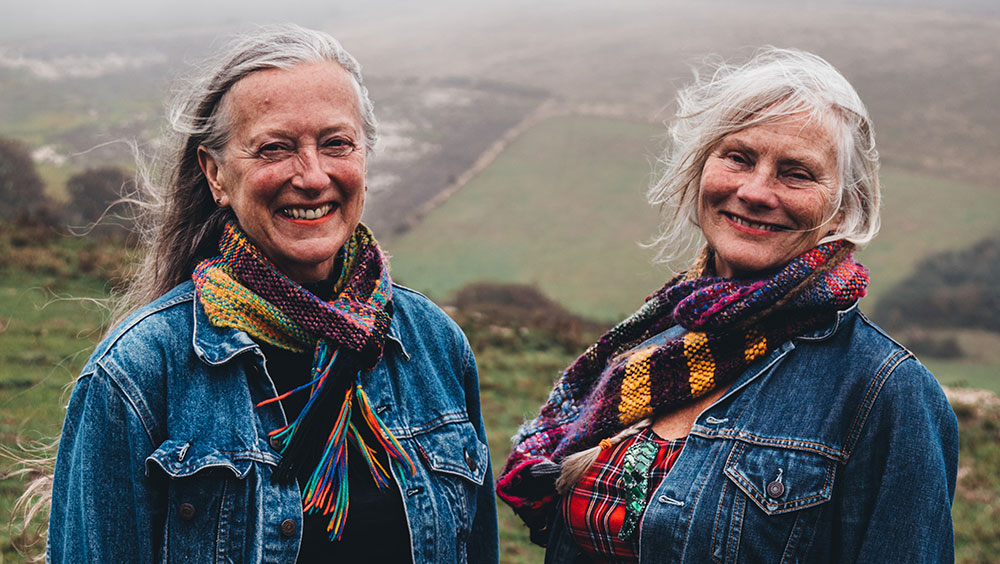
Christine and Jennifer Binnie. Photo: © Rosie Powell.
by ANNA McNAY
Christine and Jennifer Binnie first shot to fame in 1981, along with fellow artist Wilma Johnson, as the performance-art collective the Neo Naturists, for which they famously flashed in the British Museum, as well as in many London nightclubs. However, before the decade was out, the sisters had gone from hanging out with the likes of Grayson Perry (whom Jennifer was dating), Boy George and Marilyn, to, in Jennifer’s case, returning to live in the East Sussex countryside and becoming a mother and painter, and, in Christine’s, to working as a potter. Although never officially ceasing their Neo Naturist activities, the sisters have since focused much more on their individual practices. Coming together as the first guest curators of an exhibition drawn from the 5,000 works in the Towner Collection, however, has been an enjoyable experience for them both, bringing them back to their roots, and asking them to reflect on their own work and how to incorporate it into the show.
Christine spoke to Studio International by phone from her flat in London, while Jennifer preferred to email her answers.
Anna McNay: Can we talk a little about the exhibition you have curated at Towner, Eastbourne, Art, Life and Us? You have selected works from the 5,000 in the Towner Collection and are also showcasing new works and interventions by the two of you. What is the idea behind the show, how did you go about selecting the works from the collection, and what were you looking for in them?
Jennifer Binnie: Joe Hill, Towner’s director, asked us to curate a show from the collection, but he said in our first meeting that he would like us to include some of our own work, and that it could be an installation – possibly looking a bit like my house, which is full of different layers of artworks with many painted surfaces. We went into the collection with an open mind, not really looking for anything in particular, but, after the first couple of visits, the works we were drawn to started to fall into the categories we ended up with: woods, landscape and bodies.
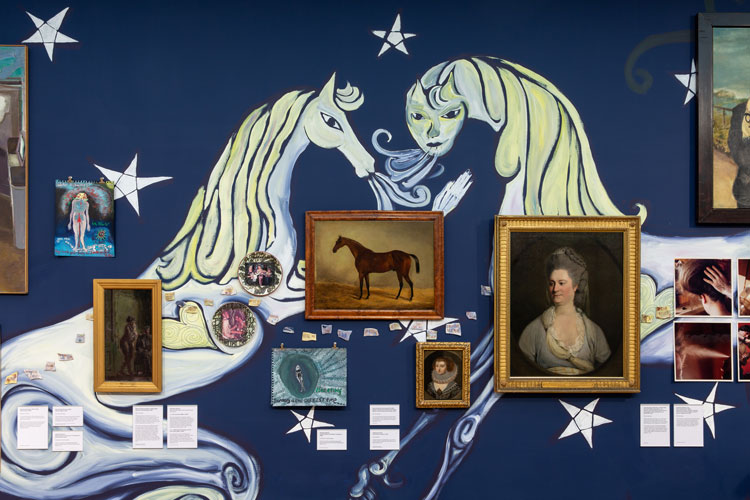
Installation View, Art Life and Us, Christine Binnie, Jennifer Binnie and the Towner Collection, Towner Eastbourne, 2020. Photo: © Rob Harris.
Christine Binnie: It all happened very quickly, surprisingly, for a big gallery. They only asked us to do it in January. When they approached us, we were just installing another exhibition together, at Kunstraum in London, so I didn’t really think much about it, and I presumed we’d go through the usual process of talking about it and looking at the pictures in depth. Our exhibition in London opened on 5 March, and we had arranged a meeting with Towner on 9 March. We turned up with pretty blank minds, because we had just done this other great big thing. I thought it was just going to be a meeting, but then they asked if we would like to look in the store. We looked at maybe half the pictures there, but very quickly, which was, as it turned out, very lucky, because then came lockdown. During this time, we were able to look at the pictures again – and the rest of the collection – on the Art UK website. I started peering at these tiny pictures and made a very long list of ones that I might possibly like, but we hadn’t really discussed what it was all going to be about, so it was just very instinctive at this stage. We basically went on the things we liked, but, as Jen says, we then realised they fitted into various themes.
One of the parts of our work that I know Towner was interested in was the fact that we do bodypainting performances – or we used to, and still do occasionally. I also used to be a life model in Eastbourne. When you’re a life model, you feel very lonely – it’s weird being in the room in the nude when everyone else has got their clothes on. So, I thought it would be nice to find as many nudes as possible in the collection. I wanted to hang them together, very purposefully. I didn’t want a nude woman on her own somewhere in the room. I wanted them to have a sense of solidarity together. It’s a different effect when there are a lot of nudes rather than just one. So that evolved into a theme.
In the end, three different themes of landscape, bodies and woods emerged. I think the landscape and woods were also influenced by our upbringing: we were brought up in Sussex and, for me, the exhibition is like coming back to Sussex, in a way, after living in London – thinking of my connections with Sussex, and how I have a deep relationship with the landscape, including the woods, why that is, and what in my work shows that.
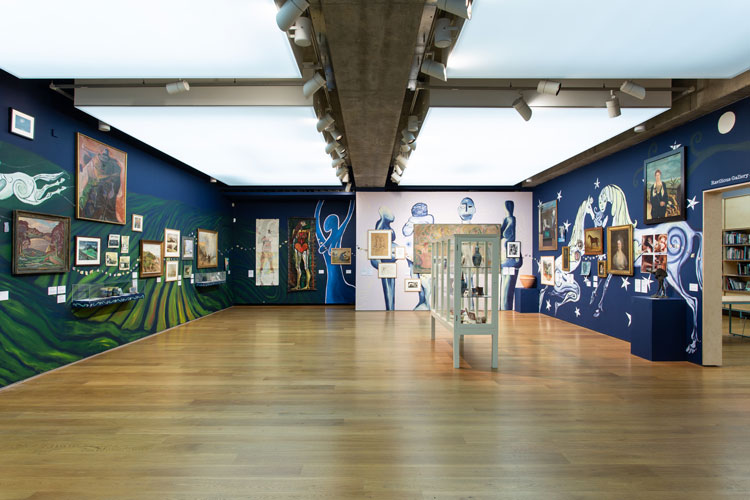
Installation View, Art Life and Us, Christine Binnie, Jennifer Binnie and the Towner Collection, Towner Eastbourne, 2020. Photo: © Rob Harris.
AMc: Coming back to the nudes briefly, are most of them by male artists, or did you find some by female artists as well?
CB: There were a couple by female artists, but they’re mainly by male artists. There’s one that we both really liked, by somebody called Phelan Gibb, who we thought was a woman, because some of his works look very feminine. The one that we have chosen, that we both loved, is of lots of nude women all together in one painting, with children and a stag – things that resonate with our own work and experiences.
JB: Yes, we both loved Gibb’s Nudes in a Landscape. There is so much about the work that resonated with us – the group of women and children, the way the background is painted and the colours used, the frieze-like quality, and I particularly like the little stag, as stags feature frequently in my own work.
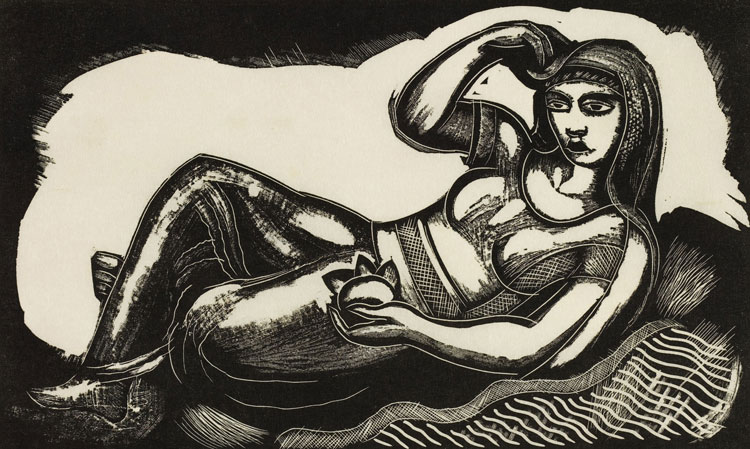
Leon Underwood, Woman of Tehuantepec, 1928. © The Artist’s Estate. Towner Eastbourne.
Other works that come to mind as particular favourites are Chris Drury’s Crow Sitting on a Fence Post and Edward Louis Lawrenson’s The Last Sussex Team. I particularly like Ilsa Rodmell’s The Chase: The Hunt, as well. I’m interested in different types of hunting scenes and have painted some myself. I particularly like the jolly feeling and naive style of this painting. Although I am not a fan of foxhunting, I am interested in the reasons why people are compelled to do it.
There were some pieces that we both really loved, too, and George Henry’s Landscape was one of those. It reminded us of going on hikes on the Downs with our parents when we were young. There is a timeless quality about this work; we thought it was more contemporary than it is.
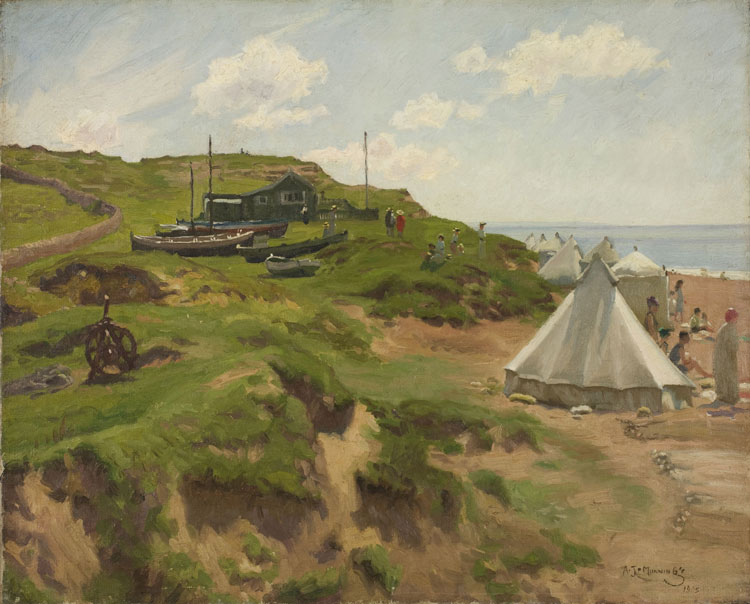
Alfred Munnings, Beach Scene, 1905. © Estate of Sir Alfred Munnings, Dedham, Essex. All rights reserved, DACS 2020. Towner Eastbourne.
AMc: Apart from the practical constraints, did the first lockdown – and the pandemic more generally – affect your selection and curatorial ideas?
JB: Yes, it did. Initially it affected the way we chose the works, as we only got that one very quick look at the collection before lockdown happened. It was some months later before we were able to look again, and, by then, the show had been brought forward, so we didn’t have that much time to make our choices – which, in a way, was a good thing.
There was one painting in particular that seemed especially relevant after lockdown, and that was Harold Mockford’s The Sick Man.
AMc: You have put some of your own works into the exhibition as well. Are these joint works or individual ones? And do they respond to specific works from the collection, or more to the overall themes?
CB: They’re individual works. What we do together is things such as this exhibition. The installation is something that neither of us could have done on our own; it’s something about working together, and the way we work together is more about talking and evolving our work together, then doing individual artworks, and then somehow combining them in the gallery. The gallery is a kind of cauldron: we put the ingredients in, and what comes out is something beyond any of the individual things, or us. This exhibition has really taken on a life of its own in that way, probably more so than anything else we have ever done.
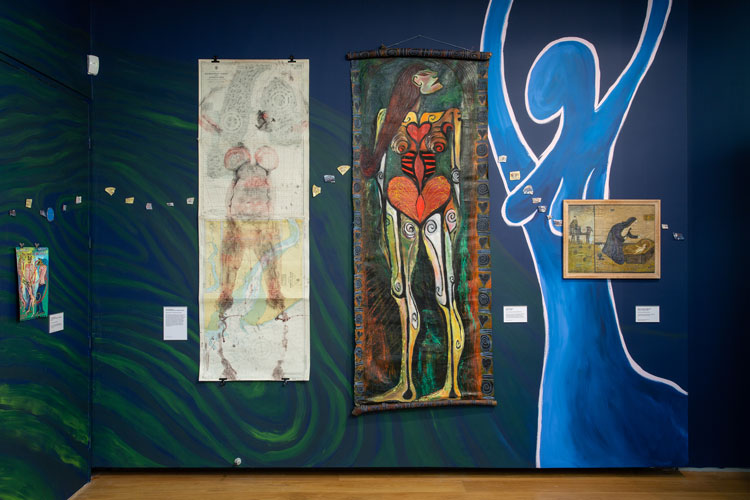
Installation View, Art Life and Us, Christine Binnie, Jennifer Binnie and the Towner Collection, Towner Eastbourne, 2020. Photo: © Rob Harris.
JB: The only work I created specifically for the exhibition is the wall painting. It provides a backdrop for the other works to sit on, setting the scene for each of the areas of landscape, woods and bodies. I had to work very quickly to get the painting done as I only had five days to complete it in. I had to be very confident with my marks and keep the painting very simple. Another piece of my own work is Woman – a life-size self-portrait painted in 1983. We both have a life-size self-portrait in the show. I also included my works A Little Hut in the Woods, which was perfect for the woods section, as it depicts a caravan encampment in the forest, and Woman in the Woods, which also fits nicely in that section. I put one of my own hunting scenes near to Rodmell’s work and also included some pages from a painted diary that I made in 2004-05. Some of the pages seemed especially relevant – for example, the one about viruses. The only piece we worked on together is the tent we are using to project films on to. We developed the idea along with Karen Taylor, Towner’s exhibitions and collections curator, and then created an installation inside the tent – an installation within an installation.
CB: Yes, I made the tent out of bent hazel, and, as Jen says, there’s a little installation within the installation. We both put some works inside it, and there are two dolls in there that are like us. We had to compromise quite a lot with what we had in the exhibition because of Covid and not being allowed too many objects in the room, so as to leave space for people to walk around. That’s why we had the idea of making a structure, and, to start with, I was a bit ambitious and wanted to build a Mesolithic house in the gallery. We came to a compromise with the tent, and I bought some fabric, which I left in my sister’s garden for a month, under the trees, while it was blackberry season. This was on purpose so that the material wouldn’t be bright white, but dyed by the birds and the insects that walked over it and dropped blackberries on it. We washed it to get the worst of it off, but it’s left this piece of material looking very weathered and as if it has been in the woods for years. It has a direct connection with the outside.
Other than the tent, while Jen was painting the walls in this giant gallery, I was stuck in London for the whole of lockdown with only a tiny bit of clay, thinking: “What can I do?” I realised I needed to do something tiny, so I started making lots of little, what I call, flying carpets. Sometimes they become brooches, and I was selling some of them as brooches on Instagram, and then I started arranging them and photographing them, and people were saying that was an artwork in its own right. I got obsessed with making these tiny things and writing the words that were somehow resonant for me each day. Then, when I was thinking about the exhibition, words to do with the exhibition started coming into the words I was writing on the flying carpets. In the end, I made some especially for the exhibition. So, my contribution is this thread of tiny things that go around the room like a layer of archaeology. It’s almost as if, were the gallery a landscape, and were we the archaeologists of the future, this layer of flying carpets would define the layer of archaeology that’s the Covid layer. They’re not only about Covid, but then Covid isn’t only about Covid, it’s about life for everybody during Covid.
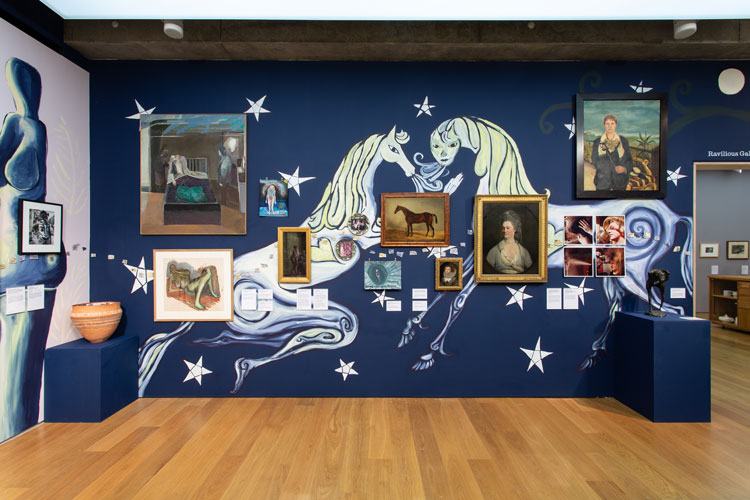
Installation View, Art Life and Us, Christine Binnie, Jennifer Binnie and the Towner Collection, Towner Eastbourne, 2020. Photo: © Rob Harris.
AMc: The flying carpets, then, were part of your practice already, but they have changed and developed as a result of thinking about and working in the context of the show?
CB: Definitely – in the context of the show and in the context of Covid.
AMc: Jen, how has looking at the collection fed into your practice?
JB: Looking at artworks is always inspiring. Most of the works in the Towner Collection are paintings, so, for me, as a painter, they are especially interesting. I haven’t had time to properly focus on my work yet, but, when I do, I know that something of the whole experience will feed in – it always does.
Working collaboratively with Christine, it was good to have the collection works to focus our ideas on. When we work together, I sometimes feel we have too many ideas and try to fit too much in. This exhibition is very full, but having the collection works at the centre of it somehow connects everything else.
AMc: Can you say a little bit about your practice? Do you have a specific studio routine?
JB: I like to be alone when I work on my paintings – and very quiet. I have just bought a new space in Hastings that will be for working in and displaying my own and other people’s work. I’m looking forward to getting over there and using the space to create some large-scale works in oil on canvas. I have always liked painting big. However, a lot of my time these days is spent on more administrative tasks. Time when I can be alone and focused on my work is becoming more and more precious. I need quite long stretches of time to be able to focus on my painting. I am lucky to have just received some funding from Arts Council England, which will allow me two days a week to focus on my work for almost a year. I am very excited to see what develops out of that. I’m really developing new routines at the moment as I haven’t yet got used to working in Hastings yet. I hope to be spending long days over at the studio, where I can be away from the distractions of home.
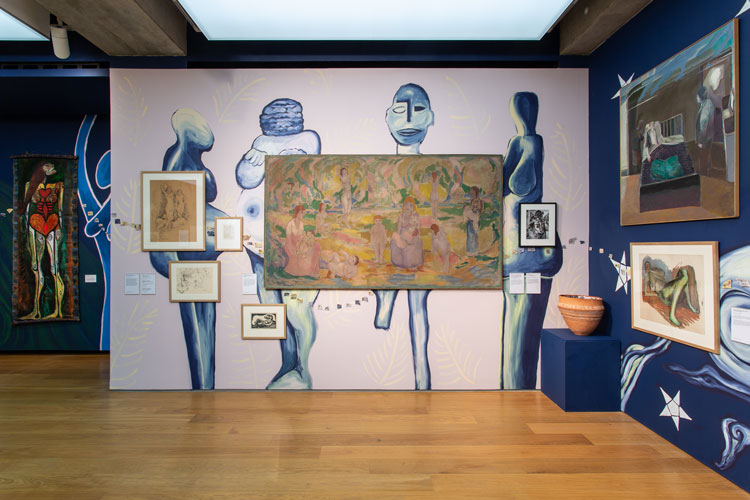
Installation View, Art Life and Us, Christine Binnie, Jennifer Binnie and the Towner Collection, Towner Eastbourne, 2020. Photo: © Rob Harris.
AMc: In the 1980s, the pair of you, together with Wilma Johnson, formed the anarchic art collective the Neo Naturists, and famously flashed in the British Museum, as well as in many London nightclubs. What was the idea behind the collective, and what distinguished you from other performance collectives of the time?
JB: I wouldn’t say there was exactly an idea behind it, it was more like something that grew organically out of other work we were doing at the time, the relationship between us, and our reaction to the time in which we were living and working as young artists.
CB: Also, we were exploring ideas of community and the effect of being in a group of people with paint on, and the empowering effect of just being in a group of bodies – ancient ideas, rituals and anthropology. When I was a life model, I used to spend a lot of time in art college libraries waiting for my next modelling slot, and I always gravitated to the anthropology department and used to sit there and read. Anthropology and ethnography, things people did which make sense, but which mainstream culture never really thought about. We were brought up as Christians, but I enjoyed finding out about other rituals that link in with the seasons of the year, the same as Christian ones do, but that aren’t Christian; discovering different cultures and different ways of living.
JB: For me, I started doing bodypainting as a way of dressing up. I was going out with Grayson Perry at the time, and he had just come out as a transvestite. I couldn’t really compete with that and didn’t want to go around dressed as a boy, which I thought would be a bit boring, so going out wearing body paint and no clothes seemed a natural step! Soon after, I discovered that Christine and Wilma had been doing bodypainting experiments, and so we started doing them together, and the performances came out of that.
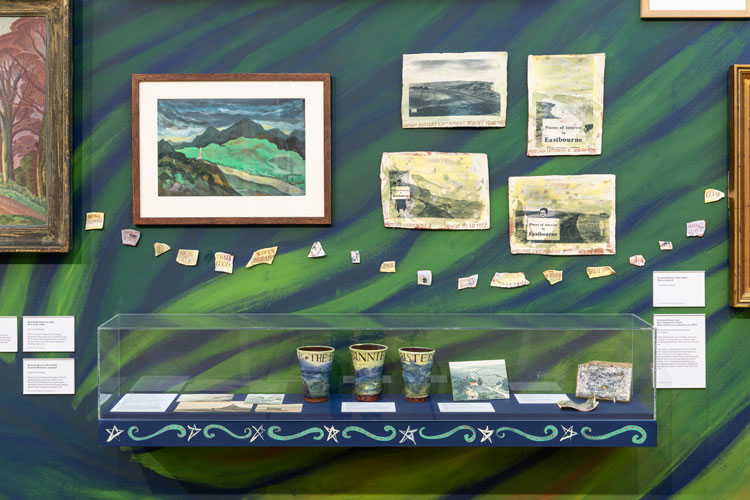
Installation View, Art Life and Us, Christine Binnie, Jennifer Binnie and the Towner Collection, Towner Eastbourne, 2020. Photo: © Rob Harris.
AMc: You recently had a retrospective at Studio Voltaire, and you have done some performances, too. What made you decide to start working together again?
CB: We never really stopped, it’s just that we are putting more energy into it again. I think it was something to do with my dad dying. My dad was an artist, and he died in 2003. He was a follower of Rudolf Steiner, and, not long after my dad died, there was an exhibition of blackboard drawings by Steiner in London, and we went to look at it, and I remember we had an amazing conversation. I can’t remember really what it was about, but we had the conversation after we had been to the exhibition, and it was about us, as artists, and where we’re going, and how we feel about our dad’s work and spirituality. When we have these kinds of conversations, things just happen. Wilma, who was the first Neo Naturist, left in the late 80s, but Jen and I have carried on doing Neo Naturism. I have carried it on without them some of the time. In the early noughties, I started the Neo Naturist Ladies’ Choir, but somehow, us getting together as sisters, separate from the Neo Naturists, and working together, was triggered by going to that exhibition after my dad died.
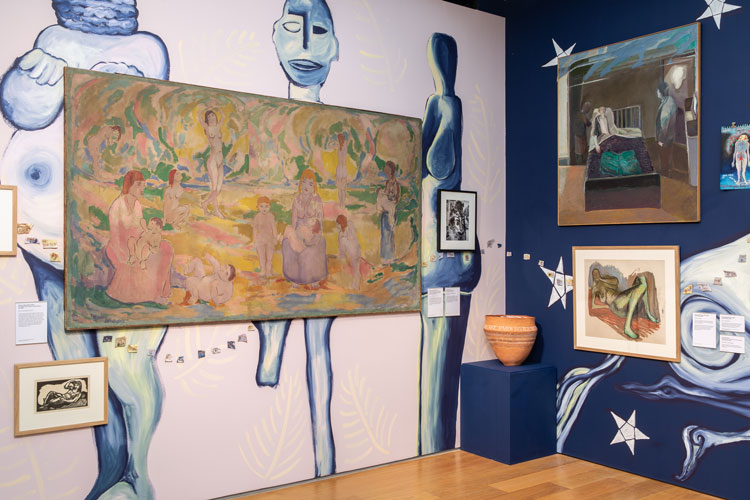
Installation View, Art Life and Us, Christine Binnie, Jennifer Binnie and the Towner Collection, Towner Eastbourne, 2020. Photo: © Rob Harris.
JB: Our work together has always been about creating installations, which draw on our family history and include elements of our individual work, that of our parents and sometimes other people. We made a conscious effort some years ago to try to engage more with the art world to move our careers on. We both felt a bit stuck for a while, and, although I have always made work, I have felt disconnected from the wider art world for many years. Working together as sisters has helped to move things on. A big part of it is the talking we do together. That’s how we work things out.
AMc: Are you equals in your partnership, or does one of you take the lead?
JB: I think we are equals, but we do take on different roles. When we have worked on these sorts of projects in the past, it has been quite difficult and has involved a lot of intense talking and, sometimes, disagreements. This time, I found the process easier. I think it’s because we had just done the other installation together and had sorted some of the stuff out doing that. Also, working with Karen helped a lot because she guided us in our decisions and perhaps acted as a referee at times!
AMc: Do you prefer working together or alone?
JB: I like both. I love working on my own on my paintings, and I need to do that more than anything, but I enjoy working in collaboration as well.
AMc: Are you close as sisters, and were you close when you were growing up?
CB: Yes, we are close as sisters. The thing that keeps our relationship going is art.
AMc: Did you grow up wanting to be artists?
JB: Not really. I was always very interested in animals and nature, and I wanted to be a vet for a while. Then I was interested in horses and thought of making a career around them. But, in the end, I chose art college, and I think I made the right decision.
CB: As I got older, it was almost like a pressure to be an artist, to be artistic, and I went to art college, and I loved it. But, in the end, after college, and then doing pottery, and coming to London, and discovering performance art and doing the Neo Naturists, I had therapy, and, when I had therapy, I worked out that you don’t have to be an artist, there are other options. That was an amazing revelation, it freed me up. I thought: “I can do whatever I want, I don’t have to be an artist,” and it was such a lovely thought. I realised I could just be me, and all the labels disappeared. So, now, I almost feel like I’m not an artist, I’m just me doing the things that I want to do. Being yourself is the best thing to be.
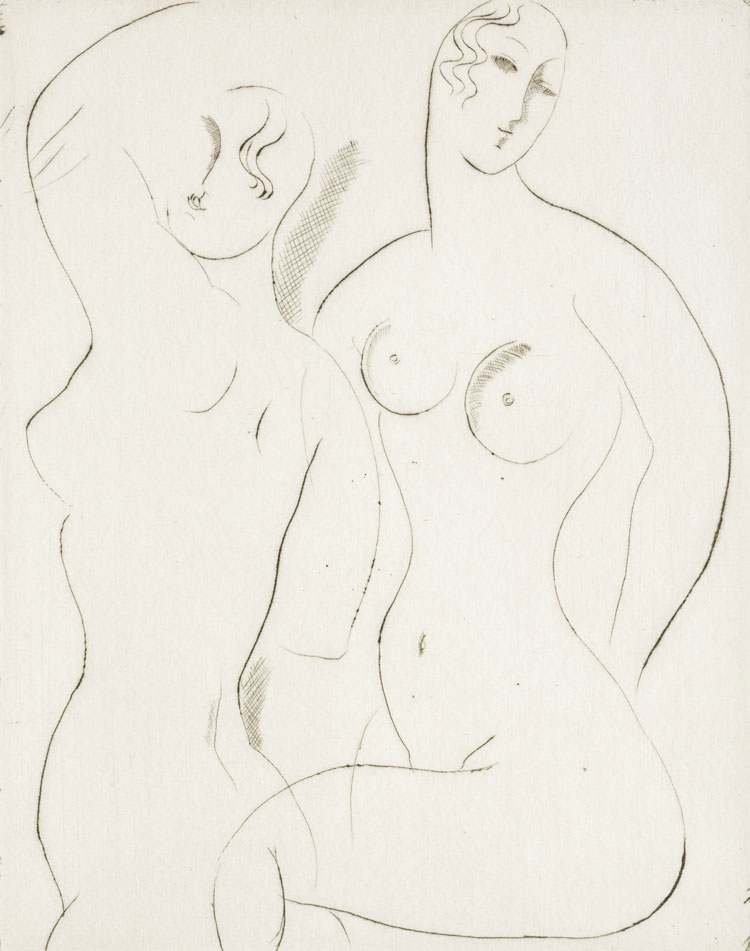
Paule Vezelay, Two Women, 1927. © The Artist’s Estate. Towner Eastbourne.
AMc: Your Facebook page states: “Drawing on their upbringing of creativity, spirituality and resourcefulness, the sisters’ work combines ceramics, paintings and archive of their performance work in the Neo Naturists. They have remained unflinching and continue to make work.” What is it about you and your practices that is unflinching?
JB: Our upbringing had a lot of teaching in spirituality and resourcefulness from our parents. As Christine mentioned, our dad was a follower of Steiner, and our mum was a very down-to-earth, practical sort of person in a “pillar-of-the-community”, gardening and wartime-thrift kind of way. These are the qualities that have influenced us and made it possible for us to survive as artists in our “unflinching” way. To me, it means that I have continued to make work that has a meaning for me, and comes from inside me, even though this kind of work hasn’t been fashionable for most of my life, and so I haven’t had much success in the art world. I have somehow managed to survive and do most of the things I want to do and continue to make art in spite of this.
AMc: Again, in the 80s, you were friends with the likes of Boy George and Marilyn, and Jen, as you mentioned, you were going out with Grayson Perry. What made you step out of this celebrity world? Do you have any regrets?
CB: Yes, I wish I had done it earlier. I don’t think it was very good for me, really, and I wish I hadn’t got so caught up in it. It’s quite limiting, and I think I’m just a bit too interested in the world to be in a ghetto, and that was a ghetto in its own right.
JB: At the time that I was going out with Grayson, he was far from being a celebrity. We lived in a squat together with hardly any money. We started to have a bit of success as artists while we were together, but I got tired of London and left Grayson and the city in 1986 to live in the countryside. I was shocked at how quickly I was dropped by the art world when I went to live in the country and had a baby, but I am long over it and certainly have no regrets.
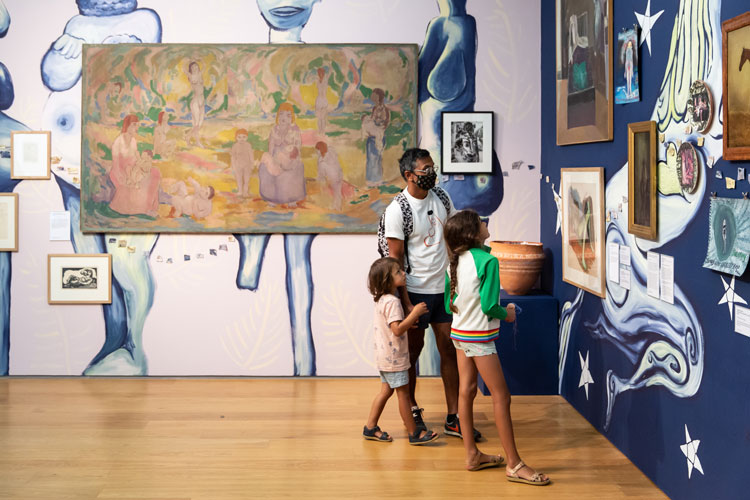
Installation View, Art Life and Us, Christine Binnie, Jennifer Binnie and the Towner Collection, Towner Eastbourne, 2020. Photo: © Rob Harris.
AMc: What has changed for you, personally, and in terms of your views on the art world, since you founded the Neo Naturist collective?
JB: Blimey! It would take an essay to answer that question. It was 40 years ago that we started the Neo Naturists, so an easier question to answer would be: “What hasn’t changed?”
CB: I never really felt like I was part of the art world. I always felt like an outsider. The YBAs and Damien Hirst certainly changed the art scene. All the boys – Boy George, Cerith Wyn Evans, John Maybury – were ambitious, and they were in that scene to try and make their ambitions happen, and a lot of them did. That’s one of the reasons I thought of starting the Neo Naturists, because when you went out to the Blitz, people always asked: “What are you doing now?” It wasn’t the normal chitchat that I was used to, coming from Eastbourne. The conversations were much more serious, about networking, and what are you doing now, and “Did you know that’s so-and-so over there?” and “Maybe you’d better go and talk to him because he’s a famous film-maker”. I thought I’d better have something to do, and I got together with Wilma and started doing bodypainting. We thought we could do performances. Part of my thinking behind that was that I would then have something to say when people asked me what I was doing. I wouldn’t just have to say I was a life model at St Martin’s and that’s it. It would sound a bit more as if I was really doing art.
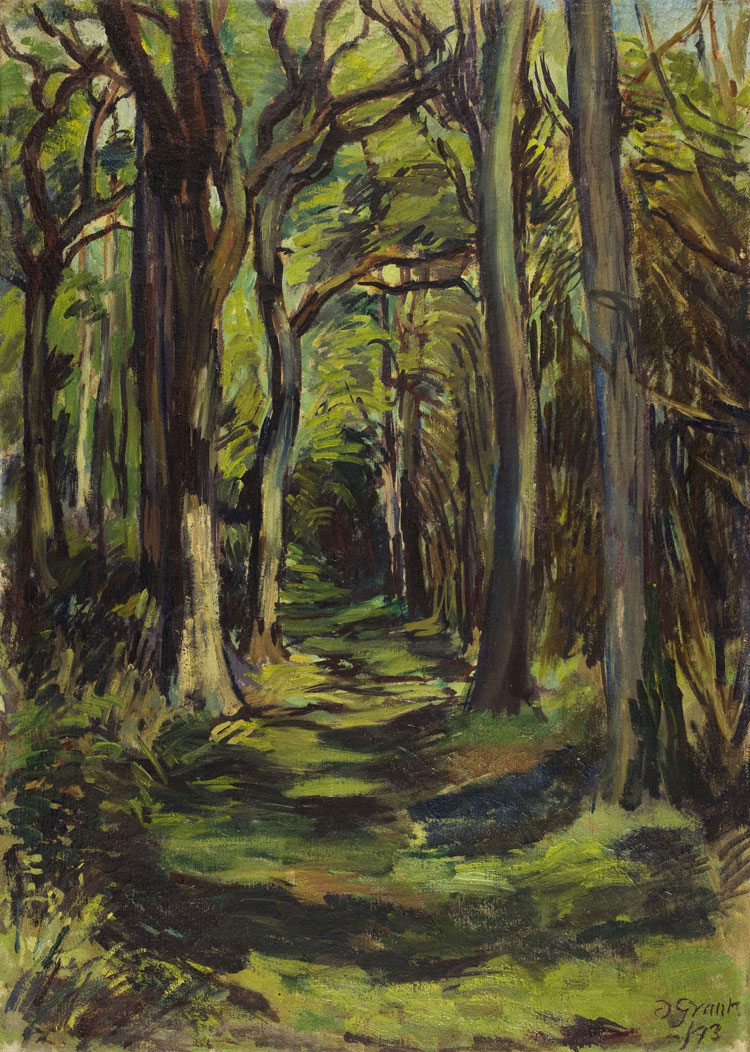
Duncan Grant, The Glade, Firle Park, 1943. © Estate of Duncan Grant. All rights reserved, DACS 2020. Towner Eastbourne.
AMc: It doesn’t sound as if things have changed that much, then.
CB: No, I don’t think they have, really. I think people like to make the differences sound bigger than they are.
AMc: You grew up near Eastbourne, went to art college there in the 70s, and have now returned to East Sussex. Do you feel a deep connection with the region? How important was this for the curation?
JB: I spent two years at Eastbourne Art College, then went off to do a fine art degree in Portsmouth, after which I spent a few years in London. I returned to East Sussex in 1986 and have lived here ever since, so, yes, this area, particularly the countryside, is ingrained in me. I am lucky to live in a small downland village and feel blessed to do so. Nature and landscape are very important to me in my life and work. It was wonderful to look through the collection and discover so many pieces that are depictions of my local area from another time. We were both drawn to these pieces, and, of course, the themes of landscape and woods reflect our interest in the countryside around Eastbourne.
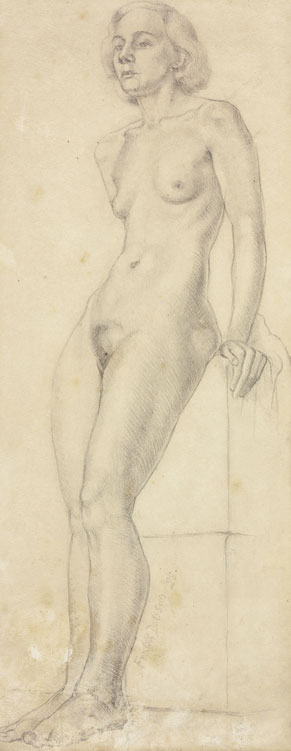
Frank Dobson, Untitled, 1928. © The Artist’s Estate. Towner Eastbourne.
AMc: Christine, I thought you had returned to East Sussex, too, but are you in London still?
CB: I’m in London, but I want to return to East Sussex. I’m in the strange position of living in quite a cheap flat in central London, and so finding somewhere I would want to live, and which I could afford, is quite hard. I can be quite free in this flat, as well. I can do whatever I want, because it’s housing association. I think when you rent places out of London, you can be quite constrained, not being able to plant what you want in the garden or paint the walls the colour you want. I would love to get down there somehow, but I haven’t managed so far. Really, I would like to find a way of living semi-communally, in a co-housing way, but not just with middle-aged women – that would be a nightmare! – but with a mix of people, including children, families, men and women. People say that co-housing is like an intentional village, and if I could find somewhere like that to move to, I’d love it.
When we were choosing the work for the exhibition, it was certainly something to do with coming back to Sussex, and tuning into Sussex, and what it is about Sussex – the landscape and the earth, really – that I feel so inspired by and have such a connection with. Some of the artworks about Sussex go back to my punk days. There is a photograph of me having my hair done when I was a punk in the bodies section, and I put that next to a picture of a vicar’s wife, Mrs Lushington, who has got amazing hair, too. We argued about Mrs Lushington, because Jen and Karen weren’t that keen on her, but I liked her because she looks quite strong and manly. Then there’s another picture, by Walter Sickert, The Poet and His Muse, and the woman is standing there with her arms crossed and looks a bit like she’s trying to protect herself. There’s a man sitting down, and it looks like he might have a tweed suit on, and I can remember that feeling, when you’re a life model, and maybe you might touch someone by mistake, or they might touch you, and they’ve got some scratchy old clothes on, and you’re cold, and it’s just horrible. When I look at that picture it reminds me of the horrible feeling of being a life model, but it’s called The Poet and His Muse, and so I thought: “Well, why can’t Mrs Lushington be someone’s muse, too?” I made a plaque to go by the side of her picture, saying “The Artist’s Muse”, and I made a plaque to go by the side of the Sickert, and I can’t quite remember what I wrote, but something like “Tea with the Vicar,” to draw attention to the weird juxtaposition of the two images, the role of women in art, what muses are, and why they have to be that way. We rejected quite a lot of pictures from the nude section that were painted by men: the most conventionally pert, with little cherubs, that kind of thing. In the Sickert, the woman isn’t like that. She looks quite normal. She looks a bit cold and fed up, I think, and that’s good because she wasn’t made to look like she was having a lovely time. But Mrs Lushington, by the look on her face, would stand for no nonsense like that at all.
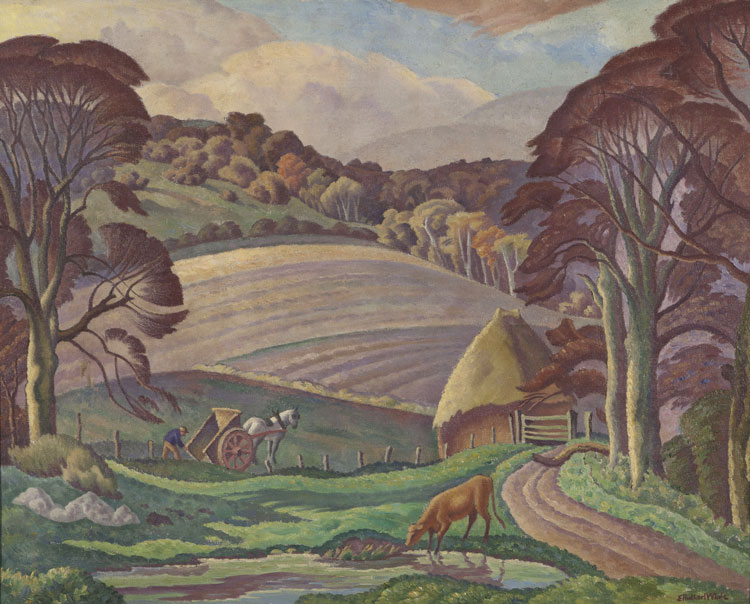
Ethelbert White, Sussex Landscape, undated. © The Artist’s Estate. Towner Eastbourne.
About 10 years ago, I went back to Sussex and spent a lot of time there, because my mum got dementia, and I became her carer. While I was her carer, I also volunteered with an organisation called the East Sussex Archaeology and Museums Partnership, and we went round prehistoric houses in school grounds and showed the children how to make string out of stinging nettles, and how to flint map an arrow, and we had all these amazing workshops about the landscape, and the archaeological features in the landscape, the different eras of archaeology, and what to look for in the woods so as to see the iron age workings. It gave me a whole other layer to the way in which I look at the landscape. All the time I was doing this, I kept thinking: “I feel like this is art, but it isn’t, I’m just a volunteer,” but I kept sketchbooks while I was doing it, and made notes, so I’ve referenced that a couple of times in the exhibition, too.
I did have one weird experience while putting the exhibition up. Most of the exhibition is about the outside, it’s about the landscape and the woods, and it’s about bodies, but the bodies connect up with the earth. We spent about two weeks putting the exhibition up, and it was during one of those lovely heatwaves we had in the summer, and, honestly, we were inside the whole time, and it just made me realise what strange environments galleries are. When you’re an ordinary person visiting, you go in, and you see these inspiring pictures of trees and landscapes, and it’s all very interesting, and then you go outside again and sit in the sunshine. But when you’re installing an exhibition, or if you work in a gallery, you’re trapped in this weird, indoors world with no windows. I was looking at the pictures, and there was a lovely picture of the sea, and so one day I said to Jen: “We’ve just got to get out, let’s go down to the beach and have a lunch break and a swim.” So, we went out, and there were all the people on the beach with their swimming costumes on, and then the sea, and I thought: “God, I thought I had been looking at the sea and at bodies in the gallery, but now I’m in the world, I realise the world is just so different from art.” Having these experiences in galleries makes you look at the world in a different way, but it was really interesting, the contrast between what I thought I was looking at, until I came out into the real world and saw the real thing, and how different from real life the gallery actually is.
AMc: Finally, how are you being impacted by this second lockdown? Are you still able to work?
CB: Yes, I am able to work in my flat. I quite enjoyed the first lockdown, because it was so serene, and I enjoyed the feeling of space, and being able to walk around London, with everywhere really quiet, and that peculiar tentativeness everybody had. Now, though, this second one seems to be all work and no play. You’re allowed to do whatever you want as long as it’s work. So, I am managing to work.
We did a residency at Towner in early October. They built a studio for us in one of the galleries, and they built me a lovely pottery. We were only there for a week, but I really made the most of it. I work in quite a nomadic way. I’ve got a pottery wheel in someone’s garden in Sussex, and I use community kilns, which I love anyway as it means I see people, because otherwise it can all get a bit me-and-a-lump-of-clay-and-nothing-else. I made 100 pots during that week, and I managed to decorate about 50 of them. I brought them all back home, and I spent a few weeks decorating the rest of them, and now I’m ferrying them to and from the kiln, which is still going, because making pottery – if you sell it – counts as manufacturing, so it’s all right, I’m allowed to do it. It’s nice to think I’m doing manufacturing! The way I work, the pots have to go to the kiln three times, so it’s all a bit gruelling. My flat is alternating between being completely empty, when all the pots are gone, and then suddenly ridiculously full, when they all come back. I’ve been doing online sales for #ArtistSupportPledge on Instagram. Once I get these pots back, I’ll be putting more on there.
• Art, Life and Us: Christine Binnie, Jennifer Binnie and the Towner Collection is at Towner Eastbourne until 16 May 2021.